 |
||
|
||
| ||
We haven't heard about Acer Labs Inc. for a long time already. Since ALi Aladdin V for Socket 7 100 MHz the company released plenty of chipsets but even our lab couldn't get good few. However, according to letters of our readers, nobody feels sorry. Nevertheless, we couldn't pass by the ALi MAGiK 1 rev. C as it promises DDR333 support. So, what can we say about the new revision of the good old ALi MAGiK 1? In fact, this is a bug-fixed version with a speedier memory controller and DDR333 support... but only in combination with a 166 MHz FSB! All other specifications are the same as in the MAGiK 1. By the way, (it is just my assumption) what was the cost of a faster memory controller? Isn't it asynchronism that they had to give up? Everybody knows that it is simpler to make a synchronous chipset... But let's turn to the participants of the test. Characteristics of the boards
Iwill XP333-R
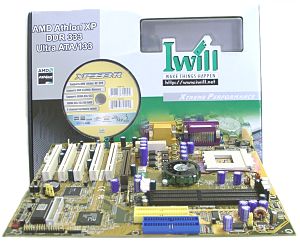 Iwill was first to release a mainboard on this chipset. But the board is a bit disappointing - apart from lack of PC2700 memory support (the DDR333 works only with a 166 MHz FSB), the board failed to start from the first attempt. In all other respects the XP333-R is a typical product from Iwill. The board comes in a plastic bag packed in a usual cardboard box with two cut-outs on the front side. There are also a user's manual, 2 ATA 66/100/133 and 1 FDD cables, a bracket for a rear computer panel with connectors for rear speakers and a central channel/subwoofer, and a CD. The latter contains drivers, manuals for different boards of this company in PDF, several hardware monitoring programs, Adobe Acrobat Reader and McAfee VirusScan 5.21. The CD is bootable - it can help you to make diskettes with drivers which can be required yet before installation of an operating system.
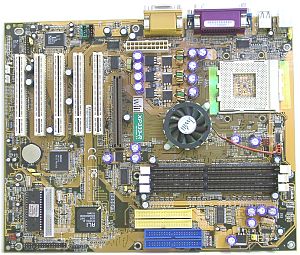 The board is of high quality, but we had some problems. Besides, the layout is not the best - positions of an FDD connector, of a power supply one and audio-ins can be an obstacle for an assembler. Besides, there is no an AGP clip for fixing a video card. On the other hand, the PCB incorporates a HighPoint chip which provides operation of the IDE RAID with the speediest interface - ATA133.
 Besides, it is possible to connect a 6-channel acoustic system direct to the board; this is supported by the C-Media chip. The socket has two nacreous stripes of plastic on its sides which protect textolite from scratches and splitting off which can take place during installation of a cooler on the CPU. The board uses a three-phase impulse voltage stabilizer which together with high-capacity LowESR capacitors provides high stability even in modes different from the rated ones. The board has several standard switches. The BIOS is based on the AWARD Modular BIOS v.6.00PG and offers a great deal of settings for memory timings, for AGP and PCI buses etc. You can change an FSB frequency in 1 MHz steps, and voltage of the processor and of the memory. The boards from Iwill can be considered reference ones for ALi chipsets because ALi itself doesn't introduce its own reference samples. ASUS A7N266
 The board is a preproduction sample, but the documentation says the differences from production ones will be minor. A standard red box contains a user's manual (in fact it is a print-out of the PDF version), and ATA 66/100 and FDD cables. The A7N266 is equipped with an ACR expansion card which can back up the sound subsystem integrated into the south bridge - the board has outputs for a 5.1 acoustic system, a linear-in and a mic-in. Besides, there is also a CD-R which probably has the same stuff as a CDROM for a production board.
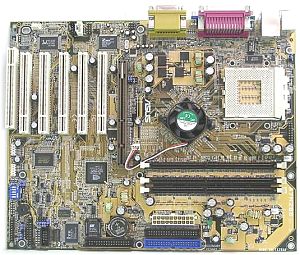 Apart from drivers it has such programs as ASUS Update (for downloading new versions of BIOS from Windows), ASUS Hotkey (which is meant for iPanel, and serves for operations enabled with hot keys), ASUS PCProbe (a utility for monitoring of fans and temperatures), and a standard freeware set - Adobe Acrobat Reader, PC-Cillin 2000 v. 7.0 from Trend Micro, Power Player SE 5.0, VideoLive Mail 4.0 from CyberLink and 3Deep (for adjusting color balance). All this stuff is included into a new installation shell which has a much better design than the old one. The board is marked as A7N266, but it's actually A7N266-E as it uses an nForce 420-D chipset (while the production boards will carry an IGP64 north bridge - with one memory controller). The boards are gonna come with a C-Media audio controller, but such boards will lack an ACR expansion card.
 The developers installed a network controller's chip from Realtek: thus, the solution is cheaper than an expansion card which realizes identical functions of the chipset. Besides, on a production board switches and other stuff will be marked differently. But this board does look finished because of high-quality soldering and excellent design. The layout is good except the fact that audio-ins are located right in front of the PCI slots. The board has an AGP Pro slot so that you can install professional graphics accelerators. There are also connectors for ASUS iPanel, and a lot of switches - both standard and specific, for example, for changing a FSB frequency. But if we close the JEN1 switch we will get the same possibility to change a FSB clock speed from the BIOS. The BIOS is based on the AWARD Medallion 6.0 and has a great deal of possibilities for adjusting the board's settings - for memory timings, AGP and PCI buses, manual distribution of interrupts. An FSB frequency can be changed in 1 MHz steps. Voltage of the processor is not fixed either. ASUS has released one more excellent product, but its too high price will scare away a great many users, taking into account a little breakaway in speed from its competitors. MSI K7T266 Pro2-RU
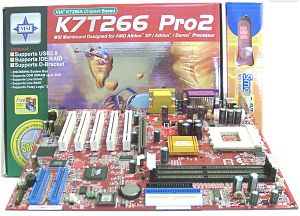 This board is also a preproduction sample: a little sticker on the back side says it. But this fact didn't affected quality and accessories. A standard box contains the board on red textolite, a user's manual in English, a sizeable description of settings, two ATA66/100 and one FDD cables, a D-Bracket with D-Leds (which are also placed on the board), 2 USB ports, a bracket with 4 USB ports, a notice from MSI how to make a correct choice of a cooler for an AMD processor, a diskette with drivers for IDE RAID and a CD. Besides, there is a SmartKey which comes in a separate box.
 The CD has drivers for motherboards, video cards and other products from MSI. Besides, there are Adobe Acrobat Reader, AMI and AWARD utilities for operation with Suspend-To-Disk function, WinFlash from AWARD for flashing BIOS from Windows, MSI programs such as LiveBIOS and Fuzzy Logic 3, PC Alert (which controls temperatures and fan speeds), GoodMem for deleting unnecessary programs from memory, X-Setup for adjusting some parameters of Windows, PCCillin 2000 - an antivirus program, 3Deep for adjusting color balance and VNC for a remote computer access. The board is of high quality, the layout is convenient. It incorporates a great deal of components. Here we have an IDE RAID on the Promise's chip, a USB controller 2.0 (we, thus, get up to 8!
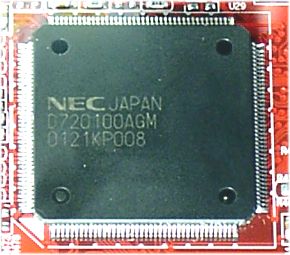 USB ports on a single board, and two are high-speed). The AGP connector has a clip to fix a video card. For the operation to be stable there are 6 capacitors. Besides, we have a piezoelectric speaker. The switches have standard functions such as CMOS clear-up, a possibility to start a computer with the help of PS/2 devices etc. The BIOS is based on the AWARD Modular BIOS v.6.00PG. There are plenty of settings for memory timings and for AGP and PCI buses. You can also change an FSB frequency, voltage of the processor and memory. The board passed all our tests and left a pleasant impression. TestsTest system:
Software
Test resultsWe decided to divide the results into two large groups, and in the first one everything is the same.



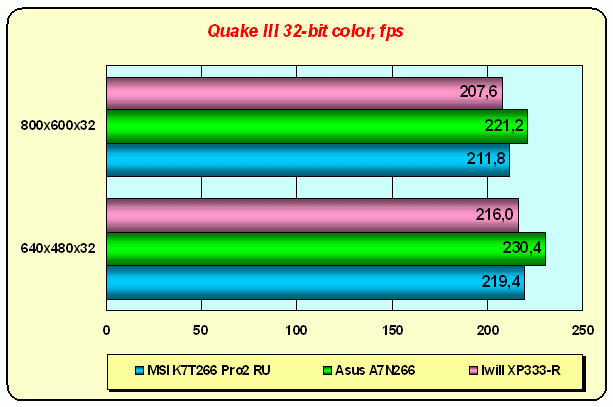


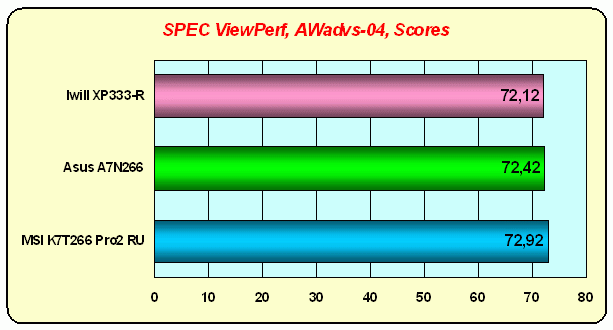
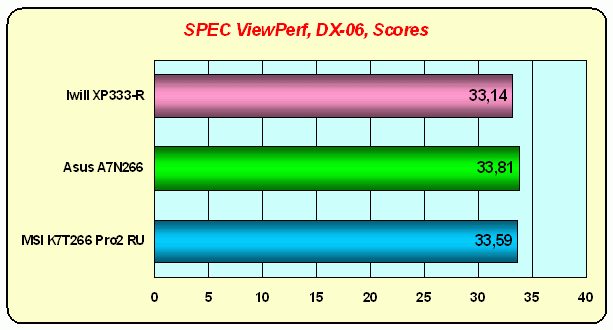

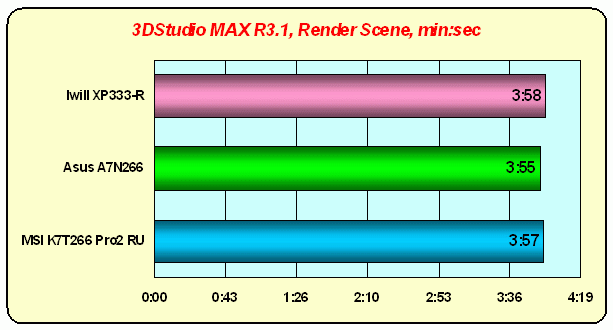

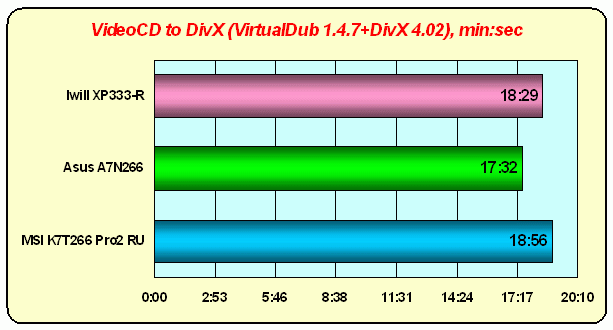
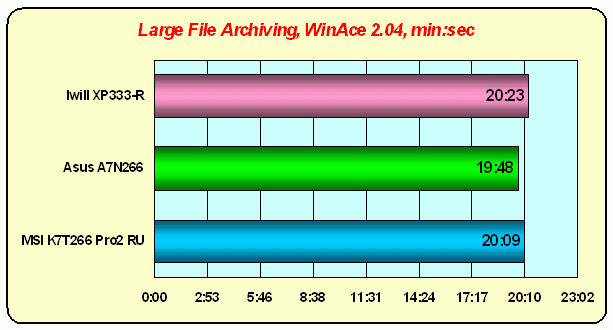
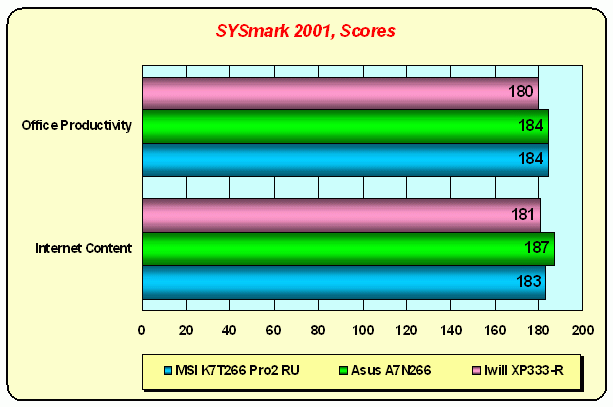 All these diagrams show the same things: the ALi MAGiK 1 rev. C can't beat the VIA KT266A, though it falls not much behind. The nForce 420-D has stable results everywhere, that is why this chipset will be the best choice for those who can afford to squander money. The VIA's chipset is the best as price/performance ratio is concerned: we have inexpensive KT266A based boards already available on the market, while nForce boards will hardly appear soon. And now the group called "a bit different from usual".
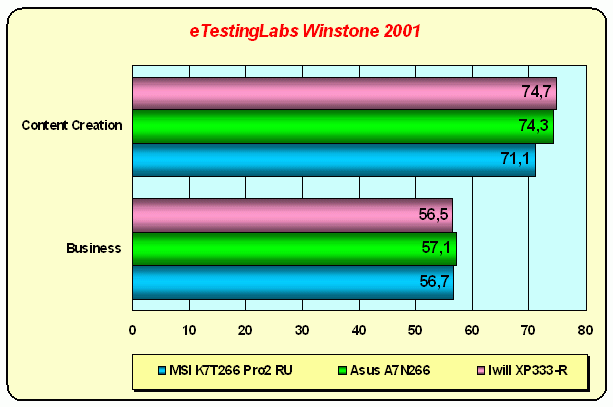 It is interesting that the MAGiK 1 comes ahead exactly in the Content Creation Winstone; it takes a 5% lead. We have carefully conducted all the tests, and we can just assume that either in the Iwill a certain function works faster or in the MSI board it is awful. And maybe it is not only the chipset which is "guilty". But even if the MAGiK 1 rev. C is really faster somewhere the fact that such result is the only of this kind proves that its "fast" function is made use of in no in real programs. That is why the following diagram disagrees with the general tendency and it hardly indicates anything.

 Well, it's too difficult to cheat a low-level test; it focuses on a single function of the chipset but it does it carefully. The MAGiK 1 has almost caught up with the KT266A in a memory read speed but it has lost in the write speed. By the way, the nForce is also not far from the KT266A in a read speed but in a write one it outpaces the others. Is it one more Intel? :) ConclusionYeah, it seems to me that we won't see anything good from Acer Labs Inc. yet a long time... The company almost failed with the Aladdin Pro / Aladdin Pro2, released a poor starting revision of the MAGiK 1 (although it was the first announced chipset for Socket A with DDR SDRAM support!), developed an awful Aladdin Pro5 / Pro5T, and now ALi gave birth to one more "miracle". The speed is moderate, though it officially (not really) supports DDR333 :) It seems that the lack of speed in ALi's products is offset by a speedy release of its new products :) We are so determined in our estimates because it's enough to count on the press to be indulgent because you are different and alternative! Mild comments on the ALi MAGiK 1, temperate reviews of the ALi Aladdin Pro5T... and now again? No. Enough. Only VIA can afford today to release a chipset which doesn't differ from the KT266A in speed and has no asynchronism support (which means that it is impossible to use the DDR333), but definitely not Acer Labs. By the way, lack of asynchonism means impossibility to use DDR333 not only with modern processors but also with processors whose FSB frequency equals 100 MHz. Does a user benefit from the MAGiK 1? The name of the company is not very popular and the company itself is not widely supported by other hardware makers. The efficiency is at the level of KT266A? So, what? The VIA KT266A is a "user's choice" for an AMD platform, and what is the ALi MAGiK 1? I don't see anybody who needs it today. I just feel sorry for Iwill. This company can produce decent competitive boards which look attractive as compared with others (WO2R and KD266). Iwill is traditionally the first to release products on Acer Labs' chipsets. But isn't it enough to spend time on ALi? :) Well, the outcome depends on a price, of course.
For example, the ALi MAGiK 1 rev. C is able to fight against SiS
735. But I doubt it can win. Because boards on ALi's chipsets are
produced by such giants as Iwill and ASUS... Well, their boards
are good, but budget-minded people would get something cheaper,
for example, from SiS. And those who are not short of money would
rather take VIA KT266A. Well, I don't think the ALi MAGiK 1 rev.
C is a promising chipset.
Write a comment below. No registration needed!
|
Platform · Video · Multimedia · Mobile · Other || About us & Privacy policy · Twitter · Facebook Copyright © Byrds Research & Publishing, Ltd., 1997–2011. All rights reserved. | |||||||||||||||||||||||||||||||||||||||||||||||||||||||||||||||||||||||||||||||||||||||||||